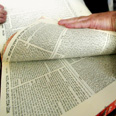
Shabbat Shalom
Photo: Ata Awisat
Since the time of the Sages, commentators have derived moral lessons from the interpretation of differences of wording in the biblical text. An example of this can be found in this week’s parasha. At the beginning of the parasha (Genesis 28:11) we read that on his way from Beer Sheba to Haran, Jacob stopped and took “the stones of the place” to place under his head. Yet, further on (28:18) we read that Jacob “took the stone which he had put under his head.” While, initially, the text speaks of stones in the plural, it later speaks of a single stone. Rashi explains:
They began to argue with one another; this one saying, “Let the righteous one place his head on me” and another one saying, “Let him place (it) on me.” God immediately, made them into one stone. This is the reason for what is said, “And he took the stone that he had placed at his head.”
Rashi provides an explanation for the difference, but is he saying that it is good that the stones argued? What motivated that dispute?
Three other commentators derive a different value lesson from the text.
The Kli Yakar associates the event with the building of the Temple. He explains that Jacob took “twelve stones, corresponding to the twelve future tribes.” Here, too, there was the potential for a dispute among the tribes, with each tribe desiring that the Temple be built in its region. The Kli Yakar then resolves the apparent contradiction between the verses with a homily:
It says: “the site that the Lord your God will choose amidst all your tribes” (Deut. 12:5), and it says “but only in the place that the Lord will choose in one of your tribal territories” (12:14). How can this be? When David purchased the threshing floor…he took the money from all of the tribes…thus the dispute amongst the stones that became in the end a single stone was a sign and an example for the future that so would be the dispute among the twelve tribes…that in the end would become a single stone…
This commentary suggests a parallel to David’s purchase of the Temple Mount, and a social message that is to be learned from the two events: A potentially divisive dispute yields unity. Yet, there is a difference between the two stories: In the story of Jacob, it is God that unites the stones, whereas in the second story, unity is achieved through the efforts of a human being – King David. Here we have an example of man imitating God (“imitatio dei”) in order to achieve peace.
The Hassidic master Ma’or Einayim suggests another approach:
“He took the stones of the place,” etc., and then it says, “he took the stone,” etc. Rashi explained: They began to argue with one another…. As we learn, the secret of the continuity of knowledge from above, from the source of unity, comes to the world of disunity, in which knowledge is divided, and this is the secret behind the dispute and disagreements among the Torah scholars. And “all of these are the words of the living God”…for this is why there were twelve stones, as knowledge is divided amongst the tribes according to their source, as we know from the what our Sages taught, that there were twelve stones as the number of the tribes of Israel, and at root they are initially all one, and each is drawn to the knowledge of the disunited world in accordance with it own nature…One gives his opinion of the Torah and the other states his opinion that is the opposite of the other…both intend a single thing, inasmuch as all draw upon a single source of knowledge, but in the world of disunity it appears divided. But when all of the disputes are elevated to the original source, to the world of unity, they unite as one, and “all of these are the words of the living God.”
Here we find a theological conception that explains the source of disagreement among the Sages, and suggests a means for achieving harmony by “elevating the dispute to the original source,” inasmuch as “all of these are the words of the living God.” Like the Kli Yakar, the Ma’or Einayim is aware of the destructive potential of disagreements in the interpretation of the Bible.
In The Path of the Just (chap. 26), Moses Hayyim Luzzatto does not describe the matter of the stones as one of dispute, but rather as an expression of their desire to draw themselves closer to Jacob’s holiness:
Holiness consists in one's clinging so closely to his God that in any deed he might perform he does not depart or move from the Blessed One, until the physical objects of which he makes use become more elevated because of his having used them, than he descends from his communion and from his high plane because of his having occupied himself with them.
A person must not descend to the level of objects and phenomena. He must ascend to holiness. This is not an easy task, and it may not even be possible. But Luzzatto provides a spiritual direction worthy of our endeavors.
Even from a minor textual disparity, we are able to derive insights that make us consider the meaning of disputes and conflicts between groups and ideas, and the reciprocal influence of the individual and society.
Rabbi Zvi Berger, The Masorti Congregation of Kfar Vradim















